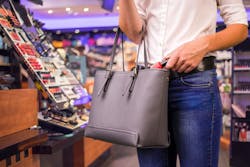According to the results of the National Retail Federation’s 13th annual Organized Retail Crime (ORC) study released on Friday, ORC continues to impact the retail at ever-increasing rate as 67 percent of loss prevention executives surveyed reported seeing an increase in the crime in the past year.
In addition, the survey also found that 96 percent of companies had experienced ORC in the past year. Losses from ORC averaged $726,351 per $1 billion in sales, an increase from $700,259 last year.
“Organized retail crime continues to be one of the biggest challenges to retailers of all sizes,” NRF Vice President for Loss Prevention Bob Moraca said in a statement. “These crimes happen across the country every day, with criminals getting smarter, more brazen, more aggressive and sometimes even attacking store employees and shoppers. Fighting ORC is a full-time job, and retailers must learn how to stay a step ahead of these thieves.”
The survey also found that six in 10 retailers had recovered merchandise from physical fencing locations including pawn shops, flea markets kiosks and temporary “pop-up” stores, about the same as last year. Criminals often turn to the internet to fence stolen items due to the anonymity it provides, however; only 56 percent of retailers polled in this year’s survey reported finding stolen goods online, down from 75 percent. And 28 percent said they had found their stolen merchandise exported illegally outside the U.S.
Among the top items stolen by ORC thieves this year include designer clothes, denim pants, razors and designer handbags. The survey found that 40 percent of retailers were victims of cargo theft — merchandise stolen on its way from distribution centers to stores or elsewhere along the supply chain — down from 44 percent last year.
Los Angeles continued to be the hardest-hit area for ORC in the nation, a position it has held since 2012. Following in order were New York City, Houston, Miami, Atlanta, Chicago, Orlando, San Francisco/Oakland, Orange County, Calif., and Northern New Jersey.
Return Fraud Continues to Rise
Return fraud continues to pose a serious challenge for the retail industry. Retailers expect 11 percent of purchases to be returned this year, and that 11 percent of those returns are likely to be fraudulent. The return rate for items purchased online but returned to a store is the same, but with a lower fraud rate of 9 percent. Of items returned without a receipt, 17 percent are believed to be fraudulent. During the holiday season, 13 percent of purchases are expected to be returned, with 11 percent believed to be fraudulent.
Of retailers that have experienced return fraud, the most common method is the return of stolen merchandise (68 percent), followed by employee return fraud (65 percent), returns of merchandise purchased on fraudulent or stolen tender (57 percent), returns made by ORC groups (54 percent), wardrobing (40 percent), returns using counterfeit receipts (29 percent) and returns using e-receipts (19 percent).
The survey of 63 loss prevention retailers representing department, big-box, discount, drug, grocery and specialty retailers was conducted September 11-October 18. Click here to learn how you can download the survey’s complete results.


